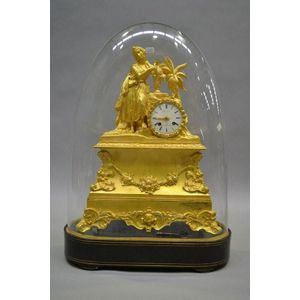French Figural Mantle Lock with Dome
You must be a subscriber, and be logged in to view price and dealer details.
Subscribe Now to view actual auction price for this item
When you subscribe, you have the option of setting the currency in which to display prices to $Au, $US, $NZ or Stg.
- Pendulum - The pendulum was discovered around 1602 by Galileo Galilei, and was adopted for time keeping by the Dutch mathematician and natural philosopher, Christiaan Huygens, who excelled in astronomy, physics, and horology.
The pendulum comprises a metal rod usually of brass or steel with a metal disk, known as a bob, at the end. The movement of the pendulum is driven by weights or a spring, and as a pendulum swings in a regular arc, it was found accuracy could be controlled to within a few seconds a week.
Timekeeping can be adjusted by changing the height of the bob on the rod, making the pendulum either swing slower or faster.
The disadvantage of the pendulum was that changes in temperature also changed the length of the pendulum, interfering with the accuracy of the clock, and so in the 18th century two types of mercurial pendulums were invented which countered the movement in the steel rod.
The pendulum was the world's most accurate timekeeping technology until the invention of the quartz clock, regulated by a quartz crystal, in 1927. - Spelter - Spelter was the name given to an alloy of zinc and brass or copper used in the 19th century for statuary and lighting. It is a brittle bluish-white metal. It was used as a cheap replacement for bronze, but being brittle easily breaks and can't be repaired. When finished it can often be mistaken for bronze, but if discreet a scratch on the base displays shows a greyish colour, the metal is spelter, if a golden colour the metal is most likely bronze.
- Alabaster - Alabaster is soft natural stone used for statuary, with a similar appearance to marble, but easier to work with. As it is softer than marble, an item made from alabaster can be scratched with a metal object, and an alabaster item does not polish to a high surface gloss like marble.
Alabaster objects can be semi-translucent. Alabaster occurs in a pure white form and also with veining from dirt. Colours vary from white through yellow and pink to brown. The veining is usually green or black but can be multicoloured.
Being semi-translucent, alabaster is often used for the bowls of figural lamps, with the figure itself being either alabaster or marble.
This item has been included into following indexes:
Visually similar items

Antique French figural mantle clock under dome, clock approx 40 cm high, 30 cm wide, dome approx 50 cm high, 40 cm wide

A French Louis XV style mantel clock, late 19th century; movement by S Marti, France, a gilt metal figural clock with an enamel dial and Roman numerals within a drum head, supported on an open scrolled and foliate apron and accompanied by a bucolic maiden

Antique French gilt bronze clock, dial signed David, St. Nicholas da Mans, Egyptian girl holding a ewer, under glass dome, standing 62 cm high in total

Antique French marriage dome, 47 cm high
